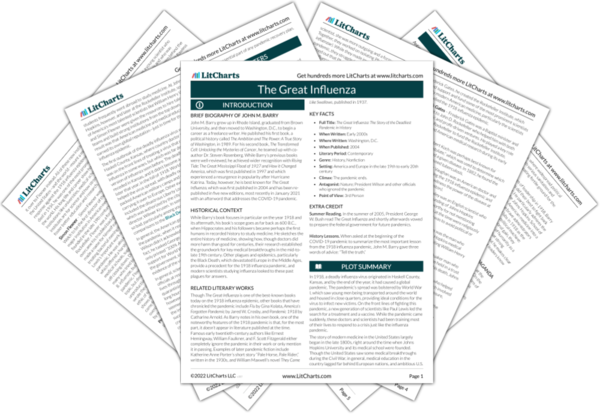Minor Characters
Oswald Avery
Oswald Avery was a dedicated research scientist who worked closely with Rufus Cole at the Rockefeller Institute. Together, they identified four different types of pneumonia and developed a serum that was effective against the first type.
Galen
Galen was an early scientist who lived 600 years after Hippocrates and who used his research on dissecting animals and treating wounded gladiators to expand on the four humors theory, setting a template for medical treatment for the next several centuries.
George Creel
George Creel was the head of President Wilson’s Committee on Public information, which censored negative news stories (including stories about the pandemic) and encouraged pro-American propaganda, all with the goal of securing American support for World War I.
John D. Rockefeller
John D. Rockefeller was arguably the wealthiest American to ever live. At the advice of his assistant, Frederick Gates, he created the Rockefeller Institute, which helped support and fund some of the most prominent scientists in early modern American medicine, particularly the scientists who studied the 1918 influenza epidemic.
Frederick Gates
Frederick Gates was a Baptist minister and an assistant to John D. Rockefeller who helped him with both philanthropic and profit-driven ventures. He played a key role in convincing Rockefeller to fund the Rockefeller Institute, which supported American medical research during its early modern period.
Robert Koch
Robert Koch was perhaps best known for creating “Koch’s postulate,” which was used to determine which microorganism caused a given disease. In 1882, he found the microorganism that caused tuberculosis.
Victor Vaughan
Victor Vaughan was an American doctor and scientist who worked during the 1918 influenza epidemic and who was one of the first to witness the power of the disease at Camp Devens (outside of Boston).
Thomas Huxley
Thomas Huxley was an English scientist who gave a keynote speech at the founding of Johns Hopkins University. His speech was noteworthy for not mentioning God, since many other universities at the time were religiously affiliated. Johns Hopkins’s objective was to avoid political or religious affiliations.
John Shaw Billings
John Shaw Billings was the man who assembled the first faculty for the Johns Hopkins medical school and who was responsible for recruiting William Henry Welch to the faculty.
Johns Hopkins
Johns Hopkins was a rich Quaker man who stated in his will that he wanted his wealth to be held in a trust and turned into a university and hospital. After his death, Johns Hopkins University was founded.
Pierre Louis
Pierre Louis was a Parisian scientist who helped introduce the “numerical system” into medicine, which involved using figures taken from body temperature, blood pressure, and other measurable signs.
Rupert Blue
Rupert Blue was Surgeon General during the 1918 influenza pandemic. He was known at the time as a lightweight and is best remembered today for failing to take decisive action.
Frederick Russell
Fredrick Russell was an American army doctor who was among the first to witness the power of the 1918 influenza epidemic at Camp Devens.
Franklin Mall
Franklin Mall was one of the more prominent early faculty members at the medical school at Johns Hopkins University.
